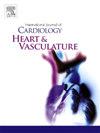肥厚型心肌病随年龄变化的肥大和纤维化动态:纵向 CMR 研究的启示
IF 2.5
Q2 CARDIAC & CARDIOVASCULAR SYSTEMS
引用次数: 0
摘要
背景本研究旨在利用心脏磁共振(CMR)评估肥厚型心肌病(HCM)患者的形态和功能改变随时间推移的进展情况。测量舒张期左心室(LV)质量,包括乳头肌和小梁评估。结果 32 名患者的平均年龄为 44 ± 16 岁(范围:11-70 岁),平均随访时间为 5.2 ± 2.4 年(范围:0.8-9.1 年)。观察到左心室质量(从 194 ± 56 g 增加到 217 ± 60 g;p = 0.0001)、室间隔壁厚度(从 18 ± 4 mm 增加到 19 ± 4 mm;p = 0.01)、LGE 质量(从 6 ± 17 g 增加到 8 ± 18 g;p = 0.006)和左心房容积(从 109 ± 41 ml 增加到 129 ± 40 ml;p = 0.0001)显著增加。随着时间的推移,左心室和右心室射血分数(LVEF 和 RVEF)均显著下降(LVEF:从 70 ± 9% 降至 66 ± 9%;p = 0.04;RVEF:从 70 ± 7% 降至 67 ± 9%;p = 0.02)。多变量回归分析显示,HCM 质量增加与年龄(B = -0.43;P = 0.02)和 LGE 质量(B = -0.46;P = 0.02)独立相关。成人左心室质量增加率的中位数为每年 1.7 克/BSA(IQR,0.6-2.7),而青少年(平均年龄:16 岁;范围:11-20 岁)则为每年 6.0 克/BSA(IQR,0.5-11.6)。LV 质量与 LGE 质量之间呈正相关(B = 0.55;P = 0.001),而 LV 质量增加率与 LGE 质量增加率之间呈反比关系(-0.37;P = 0.03)。HCM 中左心室质量、纤维化和功能衰退的变化程度可能有助于识别高危患者,强调了持续随访研究的重要性。本文章由计算机程序翻译,如有差异,请以英文原文为准。
Age-dependent hypertrophy and fibrosis dynamics in hypertrophic cardiomyopathy: Insights from longitudinal CMR studies
Background
This study aims to evaluate the progression of morphological and functional alterations over time in patients with hypertrophic cardiomyopathy (HCM) using Cardiac Magnetic Resonance (CMR).
Methods
A retrospective analysis was conducted on patients with HCM who underwent serial CMR at 1.5 Tesla. Left ventricular (LV) mass was measured during diastole, including papillary muscles and trabeculae assessment. Appearance of Late Gadolinium Enhancement (LGE) was volumetrically quantified using a 5-standard-deviation (SD) threshold.
Results
Thirty-two patients, with a mean age of 44 ± 16 years (range: 11–70 years), were evaluated after an average follow-up period of 5.2 ± 2.4 years (range: 0.8–9.1 years). Significant increases were observed in LV mass (from 194 ± 56 g to 217 ± 60 g; p = 0.0001), septal wall thickness (from 18 ± 4 mm to 19 ± 4 mm; p = 0.01), LGE mass (from 6 ± 17 g to 8 ± 18 g; p = 0.006), and left atrial volume (from 109 ± 41 ml to 129 ± 40 ml; p = 0.0001). Both left and right ventricular ejection fractions (LVEF and RVEF) significantly decreased over time (LVEF: from 70 ± 9 % to 66 ± 9 %; p = 0.04 and RVEF: from 70 ± 7 % to 67 ± 9 %; p = 0.02). Multivariate regression analysis revealed that HCM mass gain was independently associated with age (B = -0.43; p = 0.02) and LGE mass (B = -0.46; p = 0.02). The median LV mass gain rate in adults was 1.7 g per year/BSA (IQR, 0.6–2.7) compared to 6.0 g per year/BSA (IQR, 0.5–11.6) in adolescents (mean age: 16 years; range: 11–20 years). A positive correlation was found between LV mass and LGE mass (B = 0.55; p = 0.001), while an inverse relationship was observed between LV mass gain and LGE mass gain rates (−0.37; p = 0.03).
Conclusion
The range of morphological changes in HCM seems to reflect an age-related equilibrium between hypertrophy and fibrosis. The extent of changes in LV mass, fibrosis, and functional decline in HCM may help identify patients at risk, emphasizing the importance of ongoing follow-up studies.
求助全文
通过发布文献求助,成功后即可免费获取论文全文。
去求助
来源期刊

IJC Heart and Vasculature
Medicine-Cardiology and Cardiovascular Medicine
CiteScore
4.90
自引率
10.30%
发文量
216
审稿时长
56 days
期刊介绍:
IJC Heart & Vasculature is an online-only, open-access journal dedicated to publishing original articles and reviews (also Editorials and Letters to the Editor) which report on structural and functional cardiovascular pathology, with an emphasis on imaging and disease pathophysiology. Articles must be authentic, educational, clinically relevant, and original in their content and scientific approach. IJC Heart & Vasculature requires the highest standards of scientific integrity in order to promote reliable, reproducible and verifiable research findings. All authors are advised to consult the Principles of Ethical Publishing in the International Journal of Cardiology before submitting a manuscript. Submission of a manuscript to this journal gives the publisher the right to publish that paper if it is accepted. Manuscripts may be edited to improve clarity and expression.
 求助内容:
求助内容: 应助结果提醒方式:
应助结果提醒方式:


